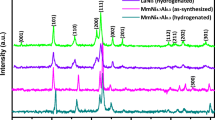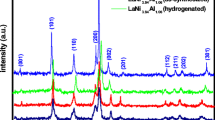Abstract
In the present study, two models of atom occupation in LaNi4Co were put forward and corresponding valence electron structures (VESs) of these two models were investigated according to empirical electron theory (EET) of solids and molecules. Results demonstrate that the VES-concerned hardness factor (F H) of LaNi4Co is lower than that of LaNi5, so LaNi4Co has lower hardness, higher plasticity and improved anti-pulverization ability. In the mean time, the difference of the equilibrium hydrogen pressure between LaNi4Co and LaNi5 was analyzed in the electronic level. The analysis shows that the strength of the weakest bond net in octahedron lattice interstices of LaNi4Co is much lower than that in LaNi5; consequently, LaNi4Co’s bond net easily deforms to accommodate hydrogen so that LaNi4Co has lower equilibrium hydrogen pressure in comparison with LaNi5. The results can provide some theory guide on the design of hydrogen storage alloys.



Similar content being viewed by others
References
Wang HB, Wang Q, Dong C, Xu F, Sun LX, Chen CL. Microstructure and storage properties of low V-containing Ti–Cr–V hydrogen storage alloys prepared by arc melting and suction casting. Rare Met. 2013;32(4):354.
Luo JJ, Wang SM, Liu J, Pan CS, Liu XP, Jiang LJ. Influence of Ti substitution for Zr on hydrogen storage property of ZrNi0.6Co0.4 alloys. Chin. J Rare Met. 2013;37(4):521.
Fu WG, Liu XP, Ye JH, Yan MY, Wang SM, Jiang LJ. Effects of doping content of potassium fluoride on hydrogen storage properties of MgH2–2LiNH2. Chin J Rare Met. 2013;37(4):526.
Willems JJG. Metal hydrides electrodes stability of LaNi5-related compounds. Philips J Res. 1984;39(1):1.
Willems JJG, Buschow KHJ. From permanent magnets to rechargeable hydride electrodes. J Less-Common Met. 1987;129(1–2):13.
Sakai T, Oguro K, Miyamura H, Kuriyama N, Kato A, Ishikawa H. Some factors affecting the cycle lives of LaNi5-based alloy electrodes of hydrogen batteries. J Less-Common Met. 1990;161(2):193.
Chartouni D, Meli F, Züttel A, Gross K, Schlapbach L. The influence of cobalt on the electrochemical cycling stability of LaNi5-based hydride forming alloys. J Alloy Compd. 1996;241(1):160.
Tliha M, Mathlouthi H, Lamloumi J, Percheron-Guegan A. AB5-type hydrogen storage alloy used as anodic materials in Ni-MH batteries. J Alloy Compd. 2007;436(1):221.
Li L, Chen RJ, Wu F, Chen S, Wang J. Theoretical analysis on electronic structure of LaNi4Co hydrogen storage alloy. Rare Metal Mat Eng. 2007;36(7):1169.
Liu Y, Wu F. Geometry and electronic structure of LaNi4M (M = Ni, Co, Fe). Chin J Mater Res. 2005;19(3):255.
Lin YF, Zhao DL, Wang XL, Zhang YH. The effects of 3d subgroup elements M-doped (M = Ti to Zn) on the electronic structure of LaNi5. Comput Mater Sci. 2008;42(1):21.
Yukawa H, Takahashi Y, Morinaga M. Alloying effects on the electronic structures of LaNi5 containing hydrogen atoms. Intermetallics. 1996;4(S):215.
Qian CF, Du H, Wang HX. Function of Co and Mn in the LaNi5 hydrogen storage alloy. Rare Metal Mat Eng. 1999;28(6):368.
Yu RH. Empirical electron theory of solids and molecules. Chin Sci Bull. 1978;23(4):217.
Zhang RL. Empirical Electron Theory in Solids and Molecules. Changchun: Jilin Science and Technology Press; 1993. 28.
Pauling L. The Nature of the Chemical Bond and the Structure of Molecules and Crystals. New York: Cornell University Press; 1960. 400.
Liu WS, Feng PZ, Wang XH, Niu JN, Shen CJ, Liu JT. Calculation and analysis of the valence electron structure of MoSi2 and (Mo0.95, Nb0.05)Si2. Mater Chem Phys. 2012;132(2):515.
Jiang SY, Li SC. Effect of valence electron structure of La–Al compounds on aluminum alloy properties. Trans Mater Heat Treat. 2013;34(7):31.
Meng ZH, Fu L, Mei J, Guo YQ. Correlations between the valence electron structures, melting points and the photoelectricity properties from tetragonal chalcopyrite crystal structure CuM(M = In, Ga)X2(X = Se, S) to CuIn0.5Ga0.5Se2. Sci Sin-Phys Mech Astron. 2013;43(3):275.
Li SC. AEC: a new tool for EET, TFDC and crystal formula. Mater Sci Forum. 2011;689:245.
Xu WD, Zhang RL, Yü RH. Calculation of cohesive energy for transitional metal compound. Sci China Ser A. 1988;18(3):323.
Brown ID. The Chemical Bond in Inorganic Chemistry—the Bond Valence Model. Oxford: Oxford University Press; 2002. 58.
Okeeffe M, Hyde BG. Stoichiometry and the structure and stability of inorganic solids. Nature. 1984;309:411.
McGibbon MM, Browning ND, Chisholm MF, McGibbon AJ, Pennycook SJ, Ravikumar V, Dravid VP. Direct determination of grain boundary atomic structure in SrTiO3. Science. 1994;266(5182):102.
Pannetier J, Bassas AJ, Rodriguez CJ, Caignaert V. Prediction of crystal structures from crystal chemistry rules by simulated annealing. Nature. 1990;346(6282):343.
Burdett JK, Hawthorne FC. An orbital approach to the theory of bond valence. Am Miner. 1993;78(9–10):884.
Gibbs GV, Hill FC, Boisen MB, Downs RT. Power law relationships between bond length, bond strength and electron density distributions. Phys Chem Miner. 1998;25(8):585.
Cheng KJ, Cheng SY. Theoretical foundations of condensed materials. Prog Nat Sci. 1996;6(1):12.
Wolverton C, Ozoliņš V. Hydrogen storage in calcium alanate: first-principles thermodynamics and crystal structures. Phys Rev B. 2007;75(6):064101.
Fischer P, Furrer A, Busch G, Schlapbach L. Neutron scattering investigations of the LaNi5 hydrogen storage system. Helv Phys Acta. 1977;50:421.
Plendl JN, Gielisse PJ. Hardness of nonmetallic solids on an atomic basis. Phys Rev. 1962;125(3):828.
Smith G, Goudy AJ. Thermodynamics, kinetics and modeling studies of the LaNi5−x Co x hydride system. J Alloy Compd. 2001;316(1):93.
Acknowledgments
This study was financially supported by National Natural Science Foundations of China (Nos. 51301149 and 50371059).
Author information
Authors and Affiliations
Corresponding author
Rights and permissions
About this article
Cite this article
Zhang, L., Li, SC. Valence electron structure and hydrogen storage property of LaNi4Co. Rare Met. 34, 259–266 (2015). https://doi.org/10.1007/s12598-015-0454-0
Received:
Revised:
Accepted:
Published:
Issue Date:
DOI: https://doi.org/10.1007/s12598-015-0454-0




